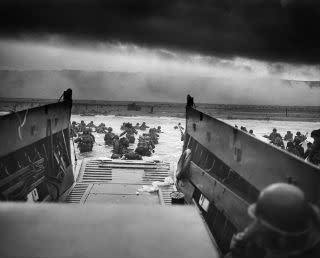Ten fascinating facts on the 72nd anniversary of D-Day

U.S. troops storm Omaha Beach on June 6, 1944
On June 6, 1944, about 150,000 troops stormed the beaches of France in the epic D-Day invasion that proved pivotal to the Allied war effort. But how did the idea originate and how did the Allies pull off such a huge task?
The numbers involved in the Normandy landings are still staggering today, and unlikely to be seen again in a modern age of combat. Here are a few of the numbers, and some fascinating facts about this historic event.
1. What does D-Day mean anyway? That remains a topic of debate today, since the operation was cloaked in secrecy. One prominent theory is that the word D-Day originated in a World War I tradition of assigning generic words like D-Day and H-Hour to events with unassigned dates. Another is that the “D” stands for the word “departed,” as in “departed date.”
2. The invading force by sea and air was staggering. The D-Day attack consisted or more than 150,000 personnel coming across the English Channel by sea and air, and about 100,000 troops were involved in the invasion on June 6.
3. The cost of the invasion was high. Of the 100,000 or so fighters in the invading force, about 9,000 were killed or wounded on June 6, 1944.
4. How rare is a major amphibious attack? Throughout history, attacks over water were a feature of many wars and campaigns, but not on the scale of the D-Day invasion. The Spanish Armada in 1588 that failed to invade England had about 130 ships and a potential 55,000 fighters. The D-Day force had about 5,000 vessels involved in various roles.
5. Was D-Day the biggest marine invasion ever? Again, that is another debate topic. Many people believe the Normandy invasion was the largest such operation during World War II, but others can make an argument for the April 1945 invasion of Okinawa in the Pacific. The 1943 Allied landing in Sicily was also a very large and complicated operation.
6. There were live broadcasts of the invasion on radio. After a German news agency scooped the Western press by confirming the invasion in a wire report, press coverage began in the Allied nations. One CBS reporter broadcasted live from a ship within the invading force. In all, more than 700,000 words recounting the events of June 6, 1944 were relayed back to the public.
7. How did the Allies fool the Germans? The grand plan included the construction of a dummy invasion force across from the Pas de Calais near Dover. Rubber ships and plywood tanks were part of the fake invasion force.
8. How did D-Day happen on June 6th? Since everyone knew an invasion of some type was imminent, so weather and timing played prominent roles. General Dwight Eisenhower picked June 5, 1944 as the date for the invasion, but bad weather forced a postponement. After meteorologists told Eisenhower that the weather would clear the next day, the invasion was on. In reality, the weather was nearly as bad on June 6.
9. Where did the name Operation Overlord come from? Winston Churchill is believed to be the person who assigned the codename to the D-Day invasion, since he had a very high interest in selecting code names. The Germans actually pioneered the use of code names in World War I.
10. What was Eisenhower’s message to the troops? Ike’s Orders of the Day told the force, “The eyes of the world are upon you.”
Related Stories on Constitution Daily
Read General Eisenhower’s official orders for the D-Day invasion
10 fascinating facts on President Dwight D. Eisenhower’s birthday

